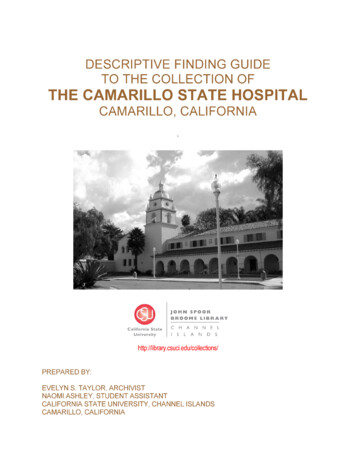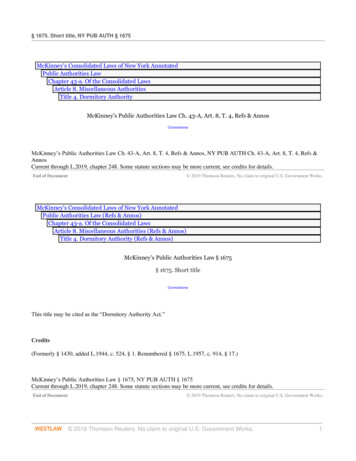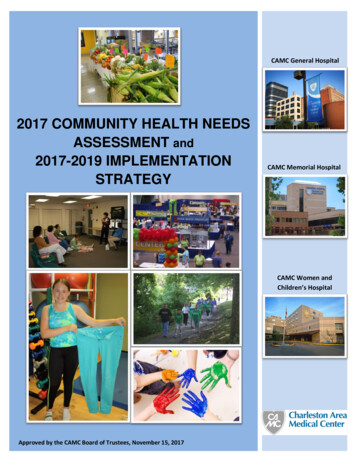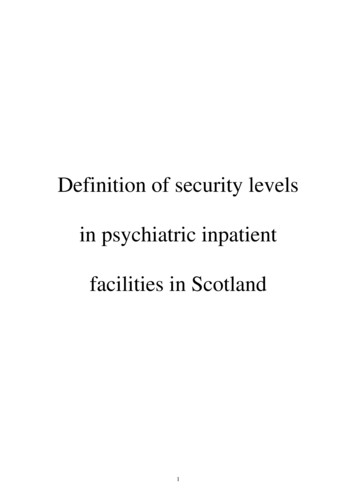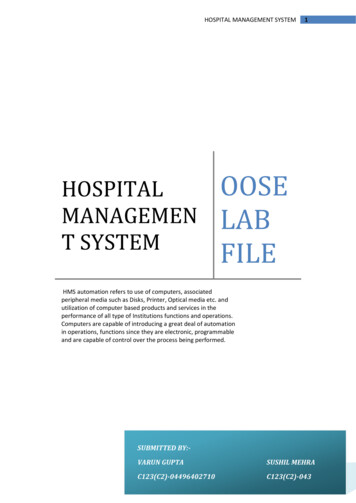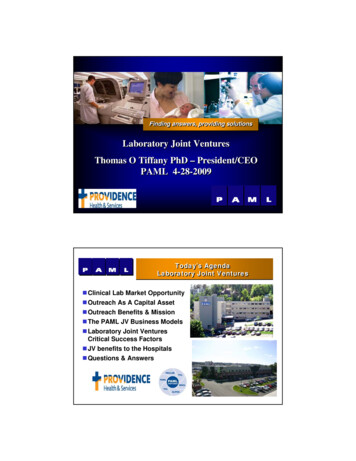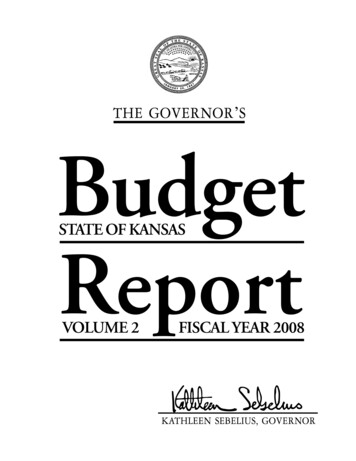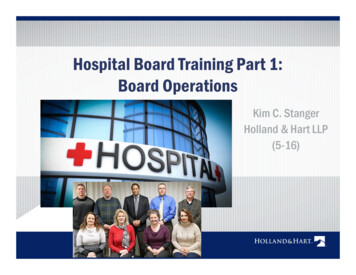
Transcription
Hospital Board Training Part 1:Board OperationsKim C. StangerHolland & Hart LLP(5-16)
This presentation is similar to any other legal educationmaterials designed to provide general information onpertinent legal topics. The statements made as part of thepresentation are provided for educational purposes only.They do not constitute legal advice nor do they necessarilyreflect the views of Holland & Hart LLP or any of itsattorneys other than the speaker. This presentation is notintended to create an attorney-client relationship betweenyou and Holland & Hart LLP. If you have specific questionsas to the application of law to your activities, you shouldseek the advice of your legal counsel.
Holland & Hart LLP
Preliminaries Written materials Presentation will be recorded and available for download atwww.hhhealthlawblog.com. If you have questions, please submit them using chat lineor e-mail me at kcstanger@hollandhart.com.4
OverviewWhat board members shouldknow about operationsKey laws board members shouldknowRules Affecting HospitalsBoard ResponsibilitiesFiduciary DutiesHospital Finance 101Consolidation and AlignmentMedical StaffCredentialing and CorrectiveAction Protections for Board Members Fraud and Abuse Laws ––––False Claims ActAnti-Kickback StatuteStarkCivil Monetary Penalties Law EMTALA HIPAA Antitrust
This is an overview of some of the basic principles. Check your own situation when it’s time to apply:– State statutes and regulations– Hospital and medical staff bylaws– Contracts
Types of HospitalsPublic (govt owned)‐ subject to state lawsregarding operations(e.g., open meeting,public records, elections,finance, etc.).‐ govt immunity.‐ board must act perstatutory obligations.Private nonprofitPrivate for profit‐ not subject to taxes.‐ greater flexibility.‐ operate for charitablepurpose, not privatebenefit or for profit.‐ subject to taxes.‐ provide charity care.‐ board must act forbenefit of shareholders.‐ board must furthercharitable mission.‐ must comply withcorporate laws.
Rules Affecting Hospitals State licensure laws and regulations.– Govern items such as physical facilities, staffing,services, governing body requirements. For example, IDAPA 16.03.14.200:– Hospital must have governing body responsible foroperation of hospital.– Governing body must: Implement bylaws governing board operations.Appoint and reappoint medical staff members.Review and approve medical staff bylaws.Hire and supervise administrator.
Rules Affecting HospitalsThere are alwaysstrings attachedto govt money.
Rules Affecting Hospitals If hospital wants to participate in govt payment programs(e.g., Medicare or Medicaid), hospital must comply with rules.– Conditions of Participation (“CoPs”). Hospitals (42 CFR 481) Critical Access Hospitals (“CAHs”) (42 CFR 485)– Rules governing payment. E.g., medical necessity, orders, supervision, etc. Fraud and abuse laws.Violation may result in exclusion from program and repayment. Certification can be achieved through:– Surveys by state licensing agency.– Accreditation by The Joint Commission.
Rules Affecting Hospitals For example, 42 CFR 481.20:– “The hospital must have an effective governing body legallyresponsible for the conduct of the hospital .”– Governing body must: Appoint medical staff members. Ensure the medical staff is accountable to the governing body. Appoint a chief executive officer who is responsible formanaging the hospital. Ensure that care is provided through licensed and qualifiedpractitioners. Ensure the hospital has a budget. Others.
Board Responsibilities Hospital mission, vision and valuesStrategic planningEffective administrationQuality patient careQualified practitionersFinancial stabilityCommunity relationsStatutory and regulatory complianceBoard education and efficient processes
Don’t get distracted by theunimportant orthings outside yourresponsibility!
Shared ResponsibilityBoard of Trustees:“ultimate authority and responsibilityfor the operation of the hospital.”Cooperation(IDAPA 16.03.14.200;see also IC 31‐3607 and ‐3617)Administration“vest[ed] with general managerialpowers over the operation of thehospital ”(IC 31‐3609)Medical Staff“responsible to the [Board] for thequality of all medical care provided thepatients, and for the professionalpractices of the members.”(IDAPA 16.03.14.250)
Board Roles Board roles may differ– Governing body– Advisory body In general, board has certain roles for:– Decision making– Policy making– Oversight of managementSee D. Arnwine, Effective Governance: The Roles andResponsibilities of Board Members Check your bylaws and particular statutes.
Board Roles: Decision Making Strategic planHire CEOCredential providersApprove budgetsOthers?
Board Roles: Policy Making Board should establish general policies that furtherhospital mission.– Board policies.– Review and approve hospital and medical staffbylaws, rules, policies. Board delegates implementation of policies tomanagement.
Board Roles: Oversight Board should oversee administration.– Establish strategic plans.– Ensure policies and processes are in place.– Require and review periodic reports fromadministration and medical staff.– Ask appropriate questions.– Follow up on issues that arise.– Hold administration accountable.
Board Roles: Oversight Board should not try tomanage day-to-dayoperations itself.– Board lacks time, training,experience, andinformation to manageeffectively.– Board needs to focus onachieving the hospital’smission, notmicromanagingoperations.
Governance v. ManagementBoard Focuses on long termobjectives. Establishes or ensurespolicies are in place. Hires and requires reportsfrom CEO. Credentials practitioners. Reviews and responds toreports.Administration Tactical steps to achievestrategic plan. Implements and enforcespolicies. Handles day-to-dayoperations. Deals with employmentissues. Prepares and makes reportsto board.
Board Authority The Board has the authority, not individualmembers.– Board must have quorum to act.– Board may delegate authority to committees orindividuals.– Individual board members lack authority to acton their own unless authorized by the board. Board member may expose themselves to liability ifhe or she acts outside scope of authority.
Fiduciary Duties
Fiduciary DutiesTrustee Fiduciary “Trustee”– Holds or cares forproperty for benefit ofothers.– One in whom trust isplaced. “Fiduciary”– Holds or cares forproperty of another.– Faithful, loyal, true, e.g.,fidelity.
Fiduciary Duties Found in statutes– Corporate code– Internal RevenueService code– Public hospital acts– Ethics in governmentacts Found in common law– Duty of care– Duty of loyalty– Duty of obedience– Duty of confidentiality
Duty of Care Board members must act –– In good faith– With the care that a person in a like position wouldreasonably believe appropriate under similarcircumstances. Take reasonable steps to become informed Make reasonable inquiry where appropriate May rely on officers, committees, or outsideprofessionals if reliance is reasonable.
Duty of Care Do not do this
Duty of Care Do not abdicate responsibilities.Prepare for meetings.Attend and participate in meetings.Review relevant info before making decision.Ask questions.Seek advice from experts, consultants or advisors.Document efforts and information in board minutes.Exercise independent judgment; do not “rubber stamp” decisions.Vote no when necessary.Do not act in haste.Establish process for requiring and then review periodic reports.Establish appropriate committees to address key areas.
Duty of Loyalty Board member must act in a mannerthe member reasonably believes to bein the best interests of the hospital.– Do not use position to gain secret profitor compete with hospital.– Do not usurp hospital opportunity.– Beware conflict of interest
Conflict of Interest Conflict of Interest board member (or relatedperson) has a financial interest in matter such that itwould reasonably be expected to exert an influenceon the member’s judgment. Board members must—– Avoid conflicts of interest.– Disclose conflict of interest to the Board.– Abstain from participating in any discussion or votingregarding any matter in which member (or related party)has a conflict of interest. Check statutes and policies.
Conflict of Interest Examples: Board is considering—– Contract with entity owned by member, member’s family, orother related person.– New service that may affect member or related person forgood or bad.– Credentialing or corrective action against physician who is apartner or competitor.– Rules or policies that may result in material financial impacton member or related person. Test: Is interest such that it would reasonably influencemember’s judgment?
Duty of Obedience Board members must act consistent with goalsand mission of hospital and in compliance with:– Applicable laws.– Bylaws.– Delegation by board. Board members may be liable for ultra vires acts,i.e., “beyond powers” or outside scope ofauthority.– Breach of fiduciary duty.– Loss of statutory immunity.– Loss of directors and officers insurance.
Duty of Obedience Health Insurance Portability and Accountability Act(HIPAA): board members who knowingly engage inimproper practices or who deliberately ignore or recklesslydisregard their legal obligations may be subject topenalties.– False claims laws– Anti-kickback statute– Stark lawSee AHLA/OIG Guidance
Duty of Obedience Become generally familiar with governing rules.– Bylaws.– Statutes relevant to board operations.– Basic statutes relevant to hospital operations,especially fraud and abuse laws. Stay within scope of authority.– When in doubt, seek expert guidance. Document “no” votes when appropriate. Ensure hospital has effective compliance plan.
Duty of Confidentiality Do not use or disclose confidential,non-public info obtained in capacityas board member without authorization. Peer review privilege applies to many board functions, e.g.,– Credentialing and peer review– Quality improvementMay waive privilege if make improper disclosures. May be liable for improper disclosures, e.g., HIPAA penalties, peerreview statute, breach of fiduciary duties. Public entities: just because you can say it doesn’t necessarilymean you should
Business Judgment Rule Board members are generally not liable for mistakesin judgment if they act—– in good faith;– with the care that an ordinarily prudent person in alike position would exercise under similarcircumstances; and– in a manner the directors reasonably believe to bein the best interests of the corporation.
Business Judgment Rule Stern v. Sibley MemorialHospital– Trustees deposited hospitalassets at local banks at lowor no interest; no reasonableinvestments.– Board members had ties tothe bank.– Finance committee nevermet in 10 years. Breach of fiduciary duty In re Caremark– Caremark had to pay millionsin fines due to violations offraud and abuse laws.– Board members sought legaladvice from lawyers.– Lawyers were wrong No breach of fiduciary duty
Hospital Finance 101 Hospitals do not operate like other businesses!
Hospitals don’t operate like other businesses* Consumers (customers) pay same price.* Must provide quality care.* Prices set above cost to make profit.* Highly regulated; can’t do things you cando in other business.* If you can’t pay, you don’t buy.* Consumers (payers) pay different prices.* Some payers (govt) pay below cost.* If you can’t pay, hospital may still haveto provide services.
Hospitals don’t operate like other businesses Must provide quality care.– Consequences are life and death. Highly regulated.– Can’t do in healthcare what you can do elsewhere Must provide some level of uncompensated care.–––––EMTALACharitable purposePublic hospital obligationsAvoid malpractice or abandonmentMoral obligation Consumers (payers) havebargaining power.– Medicare, Medicaid, etc.– Commercial payers
Payers all pay different rates Government Other programs Commercial payers– Health insurers– Employer plans Self-pay– Co-pays and deductibles– Uninsured– Underinsured Politicians and bureaucratsdetermine rates and conditions. Govt can impose penalties forfailure to comply. Providers can opt out, butdifficult to survive. Negotiated rates and conditionsdepends on bargaining power. Self pay “no pay” Individuals often lack resourcesto pay bills. Difficult to collect.
Payers all pay different rates Government Other programs Commercial payers– Health insurers– Employer plans Self-pay– Co-pays and deductibles– Uninsured– Underinsured Politicians and bureaucratsdetermine rates and conditions. Govt can impose penalties forfailure to comply. Providers can opt out, butdifficult to survive. Negotiated rates and conditionsdepends on bargaining power. Self pay “no pay” Individuals often lack resourcesto pay bills. Difficult to collect.
Medicare and MedicaidMEDICAREPROVIDERSIn 2012, Medicare, Medicaid and CHIP spent 1 trillion ( 1,000,000,000,000),36% of the USA’s total health care expenditures.
Medicare and MedicaidHealth & HumanServices (“HHS”)Centers forMedicare andMedicaidServices (“CMS”)MedicareMedicaid(Federal)(Federal State)
Medicare Federal medical insurance for:– Over age 65 who have paid or do pay into program.– Certain persons with disabilities– Persons with end stage renal disease (“ESRD”)Provided by federal govtProvided by private insurance companies
Medicare: Hospitals“The good old days ” Fee for Service– per service provided.
Medicare: Hospitals Inpatient: Prospective Payment System (“PPS”)– Set based on patient’s diagnosis using MedicareSeverity Diagnosis Related Groups (“MS-DRGs”), notservices provided. Creates incentive to be efficient, reduce utilization and costs,and reduce length of stay (“LOS”). “Average Length of Stay” is a common metric. Outpatient: Outpatient Prospective Payment System(“OPPS”)– Set based on Ambulatory Payment Classification (“APC”)groups, not services provided.
Medicare: Hospitals Critical Access Hospital (“CAH”)– Inpatient– Outpatient101% of reasonable costs based on costreport (but not all costs included in report). Disproportionate Share Hospitals– Higher reimbursement to partially offset losses fromuncompensated care. Sole Community Hospital (“SCH”)– Inpatient: cost-based reimbursement– Outpatient: APC
Medicare: Physicians Provider-Based Clinics:– Paid as outpatient department of hospital. Freestanding Clinics.– Paid the lower of— The submitted charge, or Medicare fee schedule based on the relative value score(“RVS”) associated with specific service.– Services assigned a Current Procedural Terminology (“CPT”)code. New MACRA rules will shift to value-based purchasing.
Medicare Claims Processing Medicare AdministrativeContractors (“MAC”): privatecontractors review and processMedicare Parts A and B claims. Recovery Audit Contractors(“RAC”): Private contractors whoaudit compliance and recoverimproper payments.– E.g., medical necessity, impropercoding, lack of documentation, lackof required supervision, etc.– Receive % of amounts recovered(bounty hunters).
Medicaid State welfare program for:– Low-income– Disabled Funded by federal and state.– Feds: 60% to 75% (Federal Medical Assistance Percentage or “FMAP”)– State: 25% to 40% Coverage varies by state.– Must provide certain benefits to receive federal funds.– State may opt to provide additional benefits. Payment methodology varies by state.––––Discounted fee schedulePer diemCase rateOther?
Medicare/Medicaid: the Future? Medicare trust fund is not sustainable. Federal govt is looking for ways to change.– Reduced reimbursement for providers.– Eliminating favorable payment programs.– Medicare Shared Savings Program (“MSSP”) If Accountable Care Organizations (“ACO”)achieve cost and quality goals, they receive apercentage of savings to Medicare program.– No payment for hospital-acquired conditions.– Pay for Performance (“P4P”)– Value-Based Purchasing
Medicare: Value-Based Purchasing ACOs Medicalhomes Bundledpayments Others
Commercial/PrivatePayersProviders share risk Reimbursement based on negotiated rates and terms. Discounted fee-for-service:– Fee schedule– % of usual and customary charges Case-based: Set for diagnosis regardless of servicesprovided (e.g., DRGs). Per-diem: Set per day regardless of services provided. Capitation: Set per member per month regardless ofservices (i.e., paid “per capita”). Pay for performance: (including bonuses) based onachieving outcomes or quality metrics.
Commercial/Private PayersIt’s all a matter ofcontract!The more power you have,the better deal you can get!
er tualAdjustment)AmyMedicare 100 150PPS or APCCost‐based 90 or 101BobMedicaid 100 150Discounted feesCase rate 85CathyPrivateinsurance 100 150Discounted feesCase rateCapitationPer diem 120DonSelf‐pay 100 150If able to collectCharity care 150 to 0 400 600ActualRevenueIncrease standard charge tocover unprofitable cases 295 to 456
Payer MixSelf‐payPrivateInsuranceOtherInpatient Hospital Stays iefs/sb160 fig1.jpgMedicareMedicaidHospital’s payer mix is keyfactor in profitability.
Service Mix Some hospital service are more profitable than others,depending on market and payers. Service mix is another key factor in profitability.More Profitable Surgery– Neurosurgery– Interventional cardiology– Orthopedics Ancillary services– Imaging– Pharmacy– Labs PathologyLess Profitable or Unprofitable Emergency department Obstetrics Intensive care unit Medical groups Mental health
Healthcare Finance
Healthcare ConsolidationPhysicianGroupHospitalHospital or Insurance System
Healthcare ConsolidationTrends: Hospitals purchasingphysician practices andemploying physicians(“physician integration”) Larger hospitals acquiringsmaller hospitals. Hospitals merging to joinlarger system. Hospitals and physicianpractices forming jointventures. Physicians forming networks.Why? Provide coordinated careacross spectrum. Capture referral sources. Increase bargaining powerwith payers. Participate in new paymentmodels, e.g., ACOs, MSSP,etc. Leverage increasing costs ofproviding care, e.g.,technology, compliance, etc.
Certificate of Need Some states require proposed operator to obtainregulatory approval (“certificate of need”) to buildor operate certain types of healthcare facilities. Purpose– Ensure existing providers maintain sufficient volume tomaintain proficiency.– Ensure availability of cost-effective necessary services.– For existing providers, avoid competition. Check your state law.
Certificate of Need
Corporate Practice of Medicine Some states prohibit hospitals from directlyemploying physicians. Purpose– Medical practices act do not allow corporations topractice medicine.– Concern that corporations may interfere with physicians’independent medical judgment. Check your state law.
Hospital Medical Staff
Practitioner—Hospital RelationshipPractitioners:Hospitals:Rely on hospitals toprovide resources neededfor practitioner to performsome services or provideother services to patients.Rely on practitioners toadmit patients, performservices at, or refer patientsto the facility.
Practitioner—Hospital RelationshipPractitioner:Practitioner:No ContractEmployeePrivilegesPractitioner mustbe grantedprivileges to beable to performservices at ctor
Credentialing
CredentialingMedical staff membership Group of practitioners withprivileges at facility. Membership certainrights and responsibilities. Must apply for membership. Facility’s governing boardmay grant or denymembership. Governed by med staffbylaws, rules and policiesClinical privileges Privileges privilege toperform specified servicesor procedures at facility. Must apply for privileges. Facility’s governing boardmay grant or denyprivileges. Governed by med staffbylaws, rules and policies
Board Responsibilities Quality patient care Qualified practitioners EffectiveCredentialing!Hospital mission, vision and valuesStrategic planningCommunity relationsFinancial stabilityEffective administrationStatutory and regulatory complianceBoard education and efficient processes
Who must be credentialed? All independent practitioners, i.e., those who are licensed topractice independently.– Physicians, podiatrists, dentists, dental surgeons, etc.– Allied health practitioners (“AHPs”) Advance practice nurses (e.g., nurse practitioners,CRNAs, etc.) Physician assistants Psychologists Therapists “Credentialing” may not apply to others (e.g., nurses, techs,etc.), but must ensure they are qualified.
Effective Credentialing
Effective Credentialing Effective credentialing preventive medicine– Promotes quality health care.– Avoids problem practitioners. Incompetent. Disruptive. Poor fit for organization.– Facilitates a professional workplace.– Prevents liability to patients, practitioners,employees, and the government.
EffectiveCredentialingLiability to Practitioner Due process violation Breach of contract Emotional distress Discrimination Defamation AntitrustQuality CareQuality WorkplaceLiability to Patient Malpractice Respondeat superior Negligent credentialing
“Darn it, Jim! I’m a doctor, not a ” cher!accountant!manager!salesperson!
Credentialing Courts usually do not second guess hospital’s decision if:– Followed standards in bylaws and statutes.– Based on legitimate, documented reasons Patient care or hospital operations NOT arbitrary or capricious NOT improper motive, e.g., discrimination, anti-competition,retaliation, etc. From legal liability standpoint, the process is moreimportant than the decision. Board’s job: to ensure the process is followed and decisionsare reasonable and supported by facts.
Legal StandardsCredentialing actions must comply with: Statutes and regulations– State statutes and regulations– 42 CFR 482.12 Medical staff bylaws, rules and regulations Accreditation standards Practitioner contracts Common law standards, e.g., what other reputablehospitals do
Substantive StandardsCredentialing may be based on: Current licensure Education, experience,competence, and judgment Physical and mental capability Character and professionalism Hospital capacity andcapabilities Geographic proximity Ability to satisfy medical staffresponsibilities Any other reasonable, nondiscriminatory basisCredentialing should not bebased on: Unlawful discrimination (e.g.,race, religion, sex, etc.). Anti-competitive motives ofmed staff Retaliation Licensure or membership alone Credentialing done by otherentities except telemedicine ifcertain conditions met.
Credentialing ProcessProcess is usually set out in medical staff bylaws and policies. Application– Gather information– Verify information– Databank searchesAdministration, e.g.,Medical Staff Services Active medical staff review––––Review fileInterview physicianRecommendation to boardIf recommend adverse action, give fair hearing Board review* Process may vary for physicians v. allied health professionals.
Credentialing Process:Board Review Board should exercise due care in credentialing decisions.– Do NOT rubber stamp medical staff recommendation. May rely on reasonable advice of experts, e.g., recommendationof medical staff. Board should take reasonable steps to:– Become informed.– Ask questions. To Medical Staff: “What is the basis for your recommendations?”
Credentialing: Board ReviewEnsure med staff recommendationis supported by records Administration and med staffchecked relevant sources. Administration and med stafffollowed process in bylaws. Med staff recommendation isreasonable and based onappropriate factors. Documentation supports medstaff recommendation.Beware red flags Discriminatory or inappropriateanimus by med staff. Deviations from process andstandards in bylaws. Unresolved questions orproblems in applicant’s file,e.g.,–––––References indicate problemsReferences refuse to commentDiscrepancies in info submittedUnexplained gaps in timeLoss or reduction in privileges,licensure, program participation,etc.
Credentialing Process Remember: where there’s smoke, there’s usually fire
Credentialing: Board Review Upon receipt of medical staff recommendation, Board may– Accept recommendation.– Reject recommendation.– Send back for more action.– Take its own action, e.g. Impose conditions. Require evaluation. Consult independent expert.
Privileges Board must determine privileges. “Laundry list”– Contains list of clinical procedures available at hospital.– Works well for small hospitals with limited procedures.– Requires regular updating regarding physician andprocedures. “Core privileging”– Identifies “core” qualifications to work in department.– Identifies privileges associated with the department.– Allows for additional privileges. Ensure your facility has capability to support privileges.
Telemedicine Privileges Hospital and CAH CoPs now allow hospital to rely oncredentialing done by remote hospital/entity if:–––––Have written agreement with distant site.Distant site complies with CoP standards.Practitioner privileged at distant site.Practitioner licensed in state where services provided.Hospital reviews practitioner’s performance and provides results todistant site.(42 CFR 482.12 and .22, and 485.616 and .635) Confirm it is allowed by bylaws and state licensing statutes. Confirm it does not trigger fair hearing rights. Consider exposure to negligent credentialing claim.
Emergency or Temporary Privileges In limited circumstances, hospital may grant privileges onemergency or temporary basis, e.g.,– Practitioner needed but no time for full process.– Privileges temporarily granted while formal applicationprocessed. Subject to expedited review. Automatically expires within limited time period, e.g., 60days. Be very careful and use sparingly. Ensure bylaws allow for same.
Reappointment Usually must occur at least every 2 years. Process similar to initial appointment.– Application– Review by active staff– Governing body determination Process should be stated in bylaws, rules orregulations.
Corrective Action
Corrective Action As with initial credentialing, courts usually do not second guesshospital’s corrective action if:– Followed standards in statutes, bylaws, rules, regulations andcontracts, if applicable.– Based on legitimate, documented reasons Patient care or hospital operations NOT arbitrary or capricious NOT improper motive, e.g., discrimination, anti-competition, etc. From legal liability standpoint, the process is more important thanthe decision. Board’s job: to ensure the process is followed and decisions arereasonable and supported.
Corrective Action: Process Check bylaws for process.– Peer review or other initial review process– Informal response– Summary suspension 30 days triggers NPDB report.– Formal investigation May trigger NPDB report.– Medical staff recommendation If recommend adverse action against privileges, it may triggerfair hearing requirement.– Board review and decision Obtain waiver if vary from bylaws process.
Protections forBoard Members
Liability Defenses and Protections Statutory immunity.– Health Care Quality Improvement Act, 42 USC 11101 etseq– Volunteer Protection Act, 42 USC 14501 et seq.– State protection for non-profit directors– State tort claims acts Indemnification agreements. Directors and officers liability insurance. Risk management actions.
Additional Resources92
Resources Center for Healthcare Governance,http://www.americangovernance.com/.– The Guide to Good Governance for Hospital /reports/guide-to-good-governance/. Kaufman, A Primer on Hospital Accounting andFinance (4th ed.)
Holland & Hart Resources www.hollandhart.com/healthcare– Webinar recordings– Articles– Forms– Checklists94
www.hollandhart.com/healthcareWebinarsArticles andForms95
Future Webinars Health Law Basics monthly webinar series– 6/9/16: Cybersecurity: Post Breach Response – IncidentHandling and Data Breach Communications– 6/23/16: Laws that Board Members Should Know– 7/12/16: Provider Compensation Arrangements: Employees,Contractors, and Groups– 7/21/16: Network Adequacy– 7/28/16: Accountable Care Organizations 2.0 Healthcare Update and Health Law Blog– Under “Publications” at www.hollandhart.com.– E-mail me at kcstanger@hollandhart.com.96
Questions?Kim C. StangerHolland & Hart LLP(208) 383-3913kcstanger@hollandhart.com97
as board member without authorization. Peer review privilege applies to many board functions, e.g., – Credentialing and peer review – Quality improvement May waive privilege if make improper disclosures. May be liable for improper disclosures, e.g., HIPAA penalties, peer
